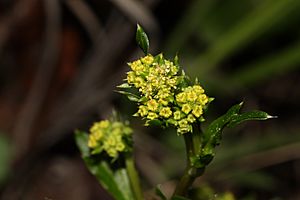Pacific blacksnakeroot facts for kids
Quick facts for kids Pacific blacksnakeroot |
|
|---|---|
 |
|
| var. tripartita | |
| Scientific classification | |
| Genus: |
Sanicula
|
| Species: |
crassicaulis
|
Sanicula crassicaulis is a type of flowering plant. It is also known as Pacific blacksnakeroot or Pacific sanicle. This plant belongs to the Apiaceae family, which includes carrots and parsley.
You can find Sanicula crassicaulis growing along the west coast of North America. It stretches from British Columbia in Canada all the way down to Baja California in Mexico. It likes many different places, such as mountain slopes, open grasslands, and woodlands.
What it Looks Like
This plant is a perennial herb. This means it lives for more than two years. It grows from a thick root called a taproot. The stem can grow quite tall, up to about 1.2 meters (nearly 4 feet) high.
Leaves
The leaves of Sanicula crassicaulis are up to 12 centimeters (about 5 inches) long. Each leaf is divided into a few deep sections. The edges of the leaves have small teeth, like a saw.
Flowers and Fruits
The plant produces groups of tiny flowers. These groups are called inflorescences. Each group has one or more small heads of flowers. Some flowers have both male and female parts (bisexual). Others have only male parts (stamen). The petals are small, yellow, and curve slightly.
At the base of each flower head, there are about five leaf-like structures. These are called bracts. They are shaped like a spear.
After the flowers bloom, the plant produces small, round fruits. These fruits are only a few millimeters long. They are covered in curving prickles. The fruits grow in small clusters.
See also
 In Spanish: Sanicula crassicaulis para niños
In Spanish: Sanicula crassicaulis para niños

